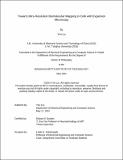Toward Ultra-Resolution Biomolecular Mapping in Cells with Expansion Microscopy
Author(s)
Liu, Yixi
DownloadThesis PDF (7.808Mb)
Advisor
Boyden, Edward S.
Terms of use
Metadata
Show full item recordAbstract
To investigate the molecular and cellular foundations of biological functions, achieving nanoscale spatial resolution in biomolecular imaging is essential. Expansion microscopy (ExM)1, a new kind of super-resolution microscopy, enables this by physically enlarging preserved biological specimens. Thus allows the investigation of structure-function relationships at nanoscale resolution using conventional diffraction-limited microscopes. ExM involves a series of chemical processes, including anchoring, polymerization, softening, and expansion. Before biomolecules are secured to the gel network, there is a risk that fixation and these chemical steps may alter the integrity and organization of the biomolecules. As resolution increases, previously indiscernible structural changes become visible, highlighting the importance of preserving ultrastructure. In this thesis, we present several ultrastructure preservation methods that minimize perturbations during sample preparation and maintain the integrity and organization of biomolecules. We name the one strategy with better performance subzero temperature expansion microscopy (subExM), which showed improved structure preservation and fluorescent signal intensity. This method holds promise for broadening our understanding of biological systems and paves the way for elucidating how structural variations underpin functional differences across healthy and diseased states.
Date issued
2024-05Department
Massachusetts Institute of Technology. Department of Electrical Engineering and Computer SciencePublisher
Massachusetts Institute of Technology